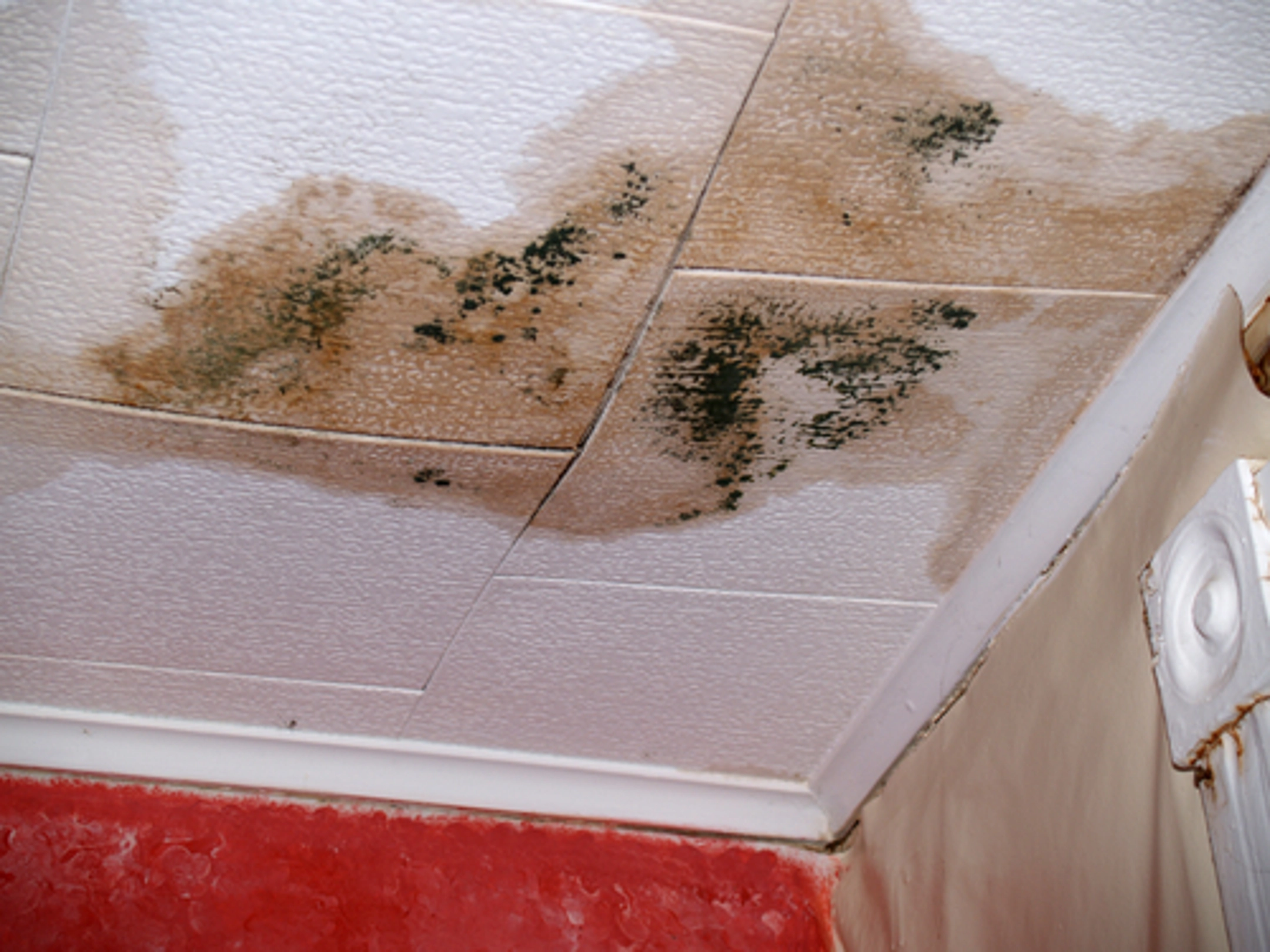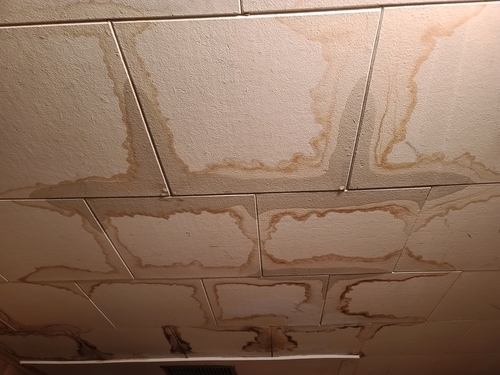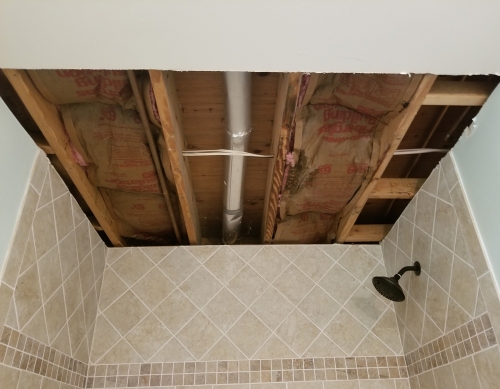
Picture this: you’ve just come back from work or a long-overdue vacation, only to find your ceiling gushing water and flooding your living room. Sounds awful, right? Ceiling water damage can cause intense destruction at a rapid pace. But if you know the signs to look for, you have a better chance of stopping a leaking ceiling in its tracks, and gathering the resources for proper repair before further damage occurs.
Signs of Water Damage in a Ceiling
Ceiling water damage has some important signs you should keep an eye out for. According to Family Handyman ceiling water damage signs include:
- Stains on your ceiling, which are often rust-colored or dark (they may be yellow)
- Peeling
- Cracks in the ceiling (often presented as hairline cracks, or a pattern of cracks)
Forbes also notes some additional signs of water-damaged ceilings:
- Mold growth, especially in corners
- Musty smells
- Sagging sections of ceiling
- Bowed sections of ceiling
- Bubbling or flaking paint
- Water rings, which are typically light brown
Bob Vila emphasizes a good rule of thumb when it comes to ceiling water damage: leaks on a higher floor are more than likely caused by a roofing issue, while leaks on lower floors (such as a basement ceiling) may be indicative of a plumbing issue.

Sources of a Leaking Ceiling
According to McCarty Insurance, the following are common sources of a leak in your ceiling:
- Leaking roof
- For professional assistance, SERVPRO® offers roof tarping services
- Dripping or leaking water pipes
- Clogged gutters and downspouts
- Home condensation
- This may be caused by faulty ventilation or insulation, or a humidifier that is set too high
Researchers at MyMove provide additional causes of a severely water-damaged ceiling, which may include the following roof-related issues:
- Ice dam buildup
- Cracked chimney
- Improperly installed skylights
- Cracked vent booting
- Improperly sealed roof valleys
- Broken shingles
- Cracked flashing
Additionally, ceiling fire sprinklers can cause damage if they malfunction, so it is important to have them routinely inspected. Visit the National Fire Protection Association for more information on sprinkler inspection.
What to Do When You Find Water Damage in Your Ceiling
Whether you find small hairline cracks in your water-stained ceiling or require major damage repair after a sagging portion gives way, it is important to take the following steps upon discovery of a water-damaged ceiling. Forbes offers the following recommendations:
- If safe to do so, locate and stop the source of the water leak
- This may involve turning off your water or placing tarp over an opening
- Move furniture and other items away from the leak, and place buckets under the leak to catch water
- Contact a professional cleanup and restoration company like SERVPRO to handle subsequent remediation, as hazards may be present
- SERVPRO maintains a network of more than 2,100 franchises across the United States and Canada, covering more than 97% of all US zip codes within two hours
- SERVPRO handles both residential and commercial water damage

SERVPRO’s Water Damage Restoration Process
When you contact SERVPRO to tackle your ceiling water damage, your local franchise’s restoration professionals will employ an eight-step process to ensure your property is returned to pre-loss condition.
- Emergency Contact. When you contact your local SERVPRO, a specialist will ask a series of questions to determine appropriate equipment and personnel.
- Inspection and Water Damage Assessment. SERVPRO technicians will arrive onsite to assess the level of damage and determine an appropriate plan of action.
- If needed, the source of water damage will be located and stopped.
- Water Removal. Extraction units and pumps are used to thoroughly remove the water.
- Damaged Material Removal. This step involves assessment and removal of non-restorable items, which will be communicated to you as the project progresses. SERVPRO technicians will attempt to remove these items as quickly as possible to speed up the drying process.
- Cleaning, Sanitizing, and Deodorization. Floors, furniture, and other belongings are cleaned with specialized equipment and techniques.
- Drying. This step involves SERVPRO specialists employing industry-leading drying equipment to extract water you can’t see. This drying equipment is usually placed upon SERVPRO technicians’ first visit to your property.
- Monitoring. SERVPRO technicians routinely visit the affected space to assess drying progress and adjust as needed.
- Repairs and Construction. At this stage of the process, final evaluations and recommendations are made, including possible construction of affected areas.
SERVPRO is Here to Help® 24/7
Water leaking from your ceiling? We’re here to help with ceiling water damage repair. With more than 2,100 franchise locations across the United States and Canada, rest assured there is a location nearby, ready to assist with your cleanup and restoration needs around the clock. From leaky ceiling repair to damaged drywall restoration, when you experience water-damaged ceilings, look no further than SERVPRO. Our technicians have over 50 years of experience and are prepared to help return your property to pre-loss condition, “Like it never even happened.”
A small leak in your ceiling or other kinds of damage due to excessive moisture are no match for SERVPRO. From water stains to ceiling damage, call your local SERVPRO today and let our restoration professionals use their knowledge to help restore your property to pre-loss condition. Each franchise has the local knowledge of your neighborhood restoration company, but the resources and equipment of a national brand, to provide elite leaking ceiling repair.
For more information, visit our FAQ and Glossary.
Sources:
https://www.forbes.com/home-improvement/roofing/what-to-do-ceiling-water-damage/
https://www.forbes.com/home-improvement/roofing/water-leaking-from-ceiling/
https://www.mccartyinsurance.com/possible-causes-your-ceiling-is-leaking/
https://www.mymove.com/home-inspiration/architectural/the-most-common-causes-of-roof-leaks/
https://www.bobvila.com/articles/who-to-call-for-water-leak-in-ceiling/
https://www.familyhandyman.com/article/what-to-do-when-your-ceiling-has-water-damage/